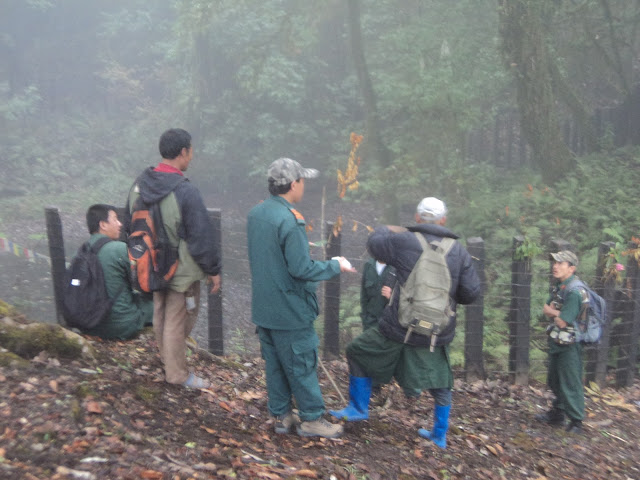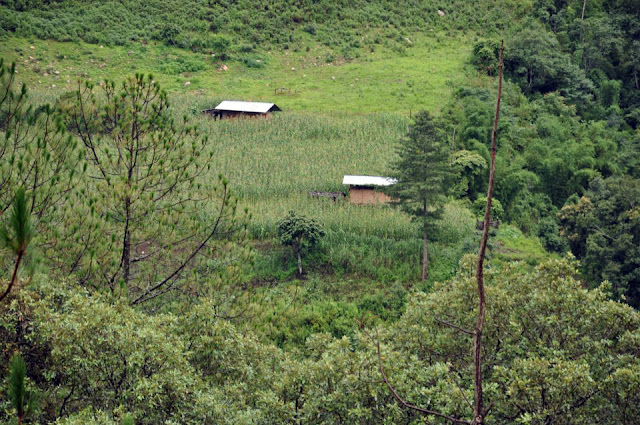NB
This article was written in 2010 as an assignment for an academic course on development management. Here are some reasons behind the developing countries’ inability to fight poverty despite their concerted effort. The inability starts from the countries poorness to faulty political systems including the richer countries trying to grab the developing nations’ natural resources for their use. The poverty is also understood to be caused by the orthodox nature of the people living in developing countries where changes are considered taboo.
An example of a humble remote village in Bhutan. No roads, no electricity. But lots of wild animals.
Chambers (1983, p. 2) laments at the appalling future prospects of miseries and finds the effort put at that time to eliminate that poverty very inadequate. He points out that the rural poverty is at its maximum in third world countries of South Africa and South Asia, and is also prevalent in Latin America and rest of Asia. Today, three decades after what Chambers (1983) has said, third world countries remain the same. The statuses of the poorer sections of the people have hardly changed. Despite of their concerted effort to fight poverty South Asia and South Africa have failed to overcome poverty the reasons for which are numerous. In Bhutanese context, the so called spatial biases brought about by urban centres, road networks (Chambers, 1983) and other activity centres of growth is very relevant as development follows, the towns, roads and the other activity centres like schools, hospitals and project sites (e.g. Punatshangchu Project), etc. While remote people are left out of vision, the urban centres and the villages having access to road network have benefited a lot and is seen as main factor for rural urban migration. All the development projects are stationed in such places where money is being already spent, staffs are in place and space for work is conducive. An example of such a project in Bhutan is that of late Dasho Nishioka’s agricultural project which failed to take root in Zhemgang but had a big success in Paro. This project displacement showed that people in rural areas makes less sense than those living in urban and developed areas, exposed to new technologies. Another bias, the person bias (Chambers, 1983) comes from those people who have access to resources. They being closer to the rural development tourists, rural researchers and developmental workers present good picture of other’s life while the real rural people are not considered as they are far away. Most of the elite farmers entertain the development workers and conveniently drag all facilities towards themselves making other farmers even poorer. Gender biases, user and adopter biases and active, present and living biases are some factors that contribute to rural poverty. Another biases called dry season bias (that affect the wet-dry tropical developing countries), diplomatic bias (where poverty is shame to be discussed, something below the dignity, juniors hiding the failed project results from seniors etc.) and professional biases (professionals in rural areas become narrowly single minded) are some of the major factors contributing to rural poverty that create more gaps between the rich and the poor. Most of the developing countries one can see are conveniently located in climatically disadvantaged and backward areas.
Beyond the rural poverty and rural situation in developing countries, the reasons behind their unsuccessful attempt to thwart poverty are lack of resources, faulty political regimes, lack of education and traditional mind set. They do not have medical technologies making them less hygienic; have very poor disease preventive services, and social services, that lead to a very restricted economic development. Majority of the developing countries are governed by oligarchy, arbitrary, and totalitarian regime, some of the examples of which are North Korea, most African countries, as well as China. The developing countries are mostly isolated from the rest of the world, and the reclusive restraint hinders them from receiving international aid as well as exchange of knowledge. For example, North Koreans have no idea what the outside world is like, because the government even bans the use of cell phone, not to mention the other rights of the citizens (Noland, 2008). Although, the case of Bhutan is different, as such restriction do not exist, the country cannot however, disagree that the phenomena of television and internet is a late entrant to the mainstream development process. Even today, there are areas in Bhutan where there are no TV and internet facilities.
China is an example of a large developing country with large population. They are known for fast development, but the kind of government they have is arbitrary. Booming economy and prosperity is the scheme they employ to keep the people under control indirectly forcing people to defer to the dictatorship. A country without freedom is as good as an open jail. Development must include freedom, peace and happiness – the recent principle of the government of Bhutan, which takes, happiness as parameter to measure development.
Being technologically behind developed countries in agriculture and others, developing countries’ agricultural as well as other production is restricted. Therefore, the supply is always disproportionate to the population demand leading to famine and emaciation in these countries. To be at the higher social status in developing countries is a challenge for the rank-and-file citizens. Therefore, inequality and widening gap between the affluent and the impoverished saturate in these countries as well. Examples of such happenings are in Saudi Arabia, Egypt, and developing countries in Africa which have the world's most petroleum reserves, that are owned by the extremely wealthy individuals, while there are lots of poor people starving (Zimbabwe United Nations Country Team, 2003), a sort of capitalism supported principles of the haves to suppress the have-nots.
One of the reasons behind developing countries’ impoverishment is the faulty political system. Civil wars, ethnic struggle and terrorism is prevalent in developing countries as their political leaders most often are totalitarians, who either want to continue to rule the country for long time or take chance to get rich once they get opportunity. In these situations, it's really hard to ameliorate the current predicament in the developing countries. Arbitrary regimes suppress people from repelling against the government and they cannot call for freedom. When people learn to defer to the totalitarian regimes, the contingency is that they will learn to accept the current status quo, without struggling for a change. However, here the case of Bhutan is altogether different. Such struggles and wars do not happen in Bhutan. Every intelligent Bhutanese have right to lawfully shine themselves and become wealthier any point of their life. Law to safeguard the citizens’ life are in place and the country is slowly moving towards equal rights for all. With the recent democratization, there is hope for the people of Bhutan to live a peaceful and happy life, more so with the importance placed by the government for the so called gross national happiness. However, the most important step is to devolve political, economic and social powers to the grass root level local government bodies (“National Report,” 2000) for a successful development projects.
One reason, according to Nickson (2002), is that the development effectiveness are reduced in poorer and smaller countries because of the mismatch in the objectives of the donor and the countries’ specific requirements supplemented by complex administrative process that results into failed ownership. The other reason is religious and the orthodox nature of the people, a kind of “unacceptable to change” residing in developing countries. Some religious faith do not favour changes and consider new developments as taboo while cultures in some poor countries promote rural existence. Further, some traditions in developing countries favour polygamy and polyandry resulting into population explosion which adds to poverty.
In sum, the developing countries’ reclusive societal norms, faulty political system, unreasonable religious principles, high population, low level of education and shortage of resources often accompanied by famine and starvation are the factors responsible for their inability to tackle poverty despite of their concerted effort in the last three decades. Even if one look ahead, the future is grim with the ever rising population and disasters like earthquake and tsunamis happenings at regular unannounced intervals that are affecting developing countries. But for Bhutan, if all things move the same way it has been going thus far, things should be safe and sound for the future. However, the most important step will be to devolve political, economic and social powers to the grass root level local government bodies for successful development projects, which is already set into motion by the current democratic government.
References
Chambers, R. (1983). Rural Development. Putting the Last First. Longman Group Limited, Longman House, Burnt Mill, Harlow. Essex CM20 2JE, England.
Ministry of women and children affairs. (2000). National report on follow-up to the world summit for children. Government of the People’s Republic of Bangladesh. Dhaka: Government Printing Office.
Nickson, A. (2002). Bolivia, a country case study prepared for the OECD DAC Task Force on donor practices. International Development Department, School of Public Policy, University of Birmingham, Birmingham B15 2TT, UK.
Noland, M. (2008). Telecommunications in North Korea: Has Orascom Made the Connection? Peterson Institute for International Economics, 1750 Massachusetts Ave., NW, Washington, DC 20008 USA.
Zimbabwe United Nations Country Team. (2003). Zimbabwe UNDAF Joint Mid-Term Review Report. Harare.
Disclaimer
This
is my personal thought and anything written here is not intended to
harm or promote people or things mentioned here. No one is authorized to
use the content of this blog for either personal or private purpose.
People mentioned here in are fictitious characters and any resemblance
to anyone with some characters or more are purely coincidence.





















